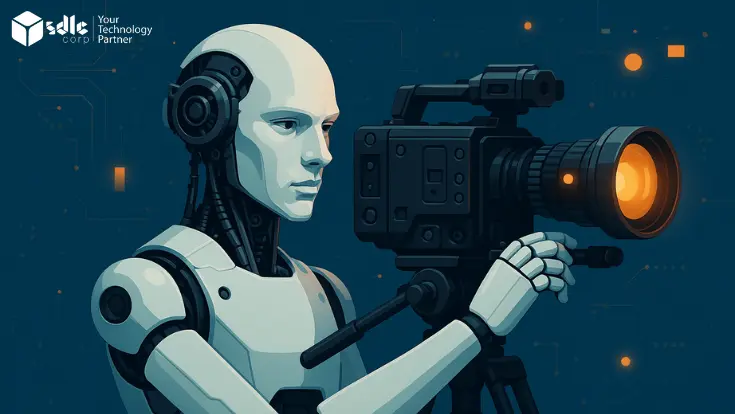The gaming industry has always embraced innovation—from pixelated 8-bit consoles to today’s immersive cloud experiences. Now, a new wave is emerging: blockchain in gaming. Once reserved for cryptocurrencies, blockchain is now revolutionizing how digital assets are owned, shared, and monetized within games.
More than a trend, blockchain gaming is transforming centralized, opaque systems into transparent, player-driven ecosystems. In this blog, we’ll explore how this technology is reshaping the way we play, build, and earn in the gaming world and why it’s poised to be the next big thing.
The Traditional Gaming Ecosystem: Limitations and Challenges

Before exploring the benefits of blockchain integration, it’s crucial to understand the limitations of the conventional gaming ecosystem:
- Centralized Control: Game publishers and developers retain full control over game assets, currencies, and player data. Gamers invest time and money into games, but they rarely own what they earn.
- Lack of Interoperability: Assets in one game are rarely usable in another. A powerful sword or rare skin in one title has no value outside its confined environment.
- Security Concerns: Centralized servers are prone to hacking and data breaches. In-game items and currencies can be lost due to security flaws or server failures.
- Unfair Monetization: Pay-to-win models and exploitative microtransactions often prioritize revenue over player experience.
These challenges are not just frustrating—they undermine the full potential of interactive digital worlds. This is where blockchain in gaming offers groundbreaking solutions.
What is Blockchain Gaming?
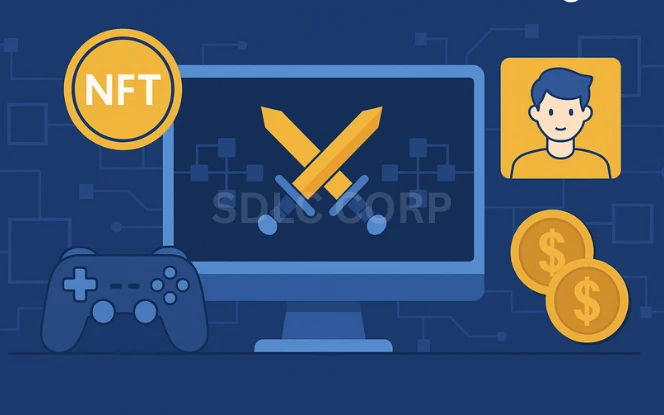
Blockchain gaming refers to video games that use blockchain technology to enhance gameplay features, asset ownership, and reward systems. At its core, blockchain is a decentralized digital ledger that records transactions in a secure and immutable manner.
By integrating blockchain, developers can create games where:
- Players truly own digital assets like skins, characters, or weapons via NFT development solutions.
- Currencies have real-world value and can be traded peer-to-peer.
- Game logic and rules can be encoded in smart contracts, ensuring fairness and transparency.
Blockchain gaming introduces a player-driven economy that thrives on trustless, decentralized networks—no intermediaries required.
Key Technologies Powering Blockchain Gaming
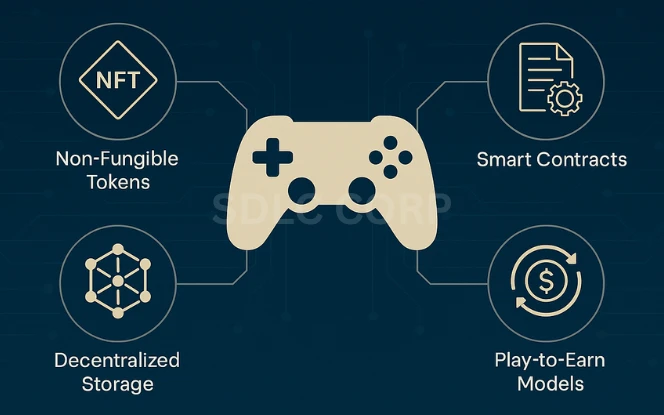
- Non-Fungible Tokens (NFTs): NFTs allow players to own unique in-game items. These items can be bought, sold, or traded on blockchain marketplaces, enabling real-world value exchange.
- Smart Contracts: These self-executing smart contracts automate game rules, reward systems, and asset transfers, ensuring transparency and fairness.
- Decentralized Storage: Rather than relying on centralized servers, blockchain games often use decentralized storage networks (like IPFS) to store game assets, reducing single points of failure.
- Play-to-Earn (P2E) Models: Unlike traditional games that monetize players, blockchain games reward them. Players can earn cryptocurrency or valuable NFTs simply by playing.
- Interoperability Standards: Projects like ERC-721 and ERC-1155 enable item interoperability across multiple games, platforms, and blockchains.
Benefits of Blockchain in the Gaming Industry
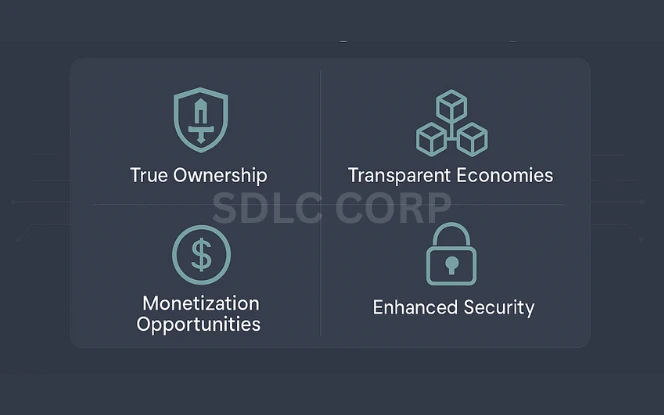
- True Ownership: One of the most revolutionary aspects of blockchain in the gaming industry is true asset ownership. Traditionally, in-game items are merely licensed to players. Blockchain transforms these into tangible digital assets that can be transferred or sold at will.
- Transparent Economies: Every transaction is recorded on the blockchain, which means there’s no room for fraud, exploitation, or manipulation. This fosters a trustworthy environment where players and developers are aligned.
- Monetization Opportunities: Players can now monetize their skills and time by earning assets that have real-world value. Developers also benefit from transaction fees, secondary sales, and more engaged communities.
- Community Governance: Some blockchain games allow players to participate in decision-making through decentralized autonomous organizations (DAOs). This shifts power from corporations to the community.
- Enhanced Security: Blockchain’s cryptographic principles ensure that transactions and assets are secure, reducing the risks of hacking and data tampering.
Real-World Examples of Blockchain Gaming

- Axie Infinity: Axie Infinity popularized the Play-to-Earn model, allowing players to breed, train, and battle digital creatures called Axies. The game economy is fueled by Smooth Love Potion (SLP), a tradable cryptocurrency.
- Decentraland: An open-world metaverse development where users can buy land, build experiences, and interact using MANA, its native cryptocurrency. It exemplifies how blockchain gaming extends beyond traditional gameplay into virtual social experiences.
- The Sandbox: The Sandbox enables players to build, own, and monetize gaming experiences. Land and assets are tokenized, and users can create value through content creation.
- Gods Unchained: A trading card game that uses NFTs to represent cards. Players own their decks and can trade them freely, unlike in most online card games where purchases are locked within the ecosystem.
The Rise of Play-to-Earn (P2E): A Game Changer
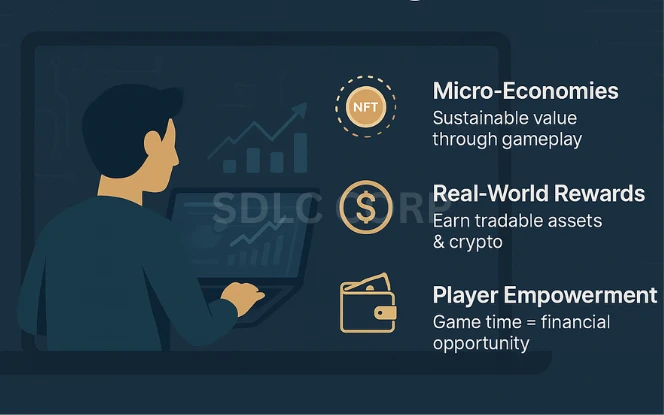
The Play-to-Earn game development model has created entire micro-economies, especially in developing countries. For some, games like Axie Infinity have become a primary source of income.
This model flips the script—games are no longer just entertainment but also viable economic opportunities. With blockchain in gaming, time invested in virtual worlds has tangible real-world value.
Challenges and Concerns
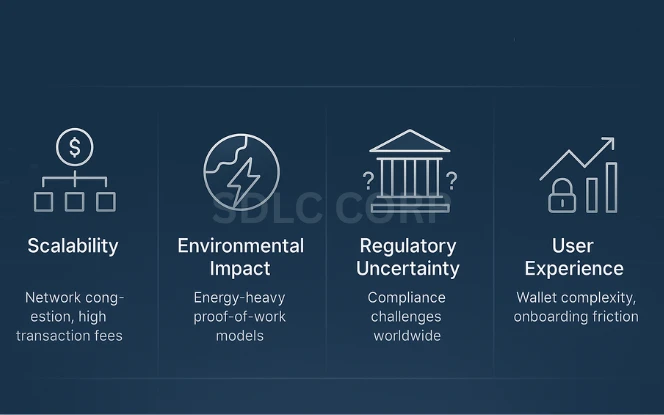
Despite the promising outlook, blockchain gaming is not without challenges:
- Scalability: Popular blockchains like Ethereum can suffer from high gas fees and network congestion, hindering real-time gaming.
- Environmental Concerns: Proof-of-Work consensus models consume substantial energy. However, newer chains like Solana and Ethereum 2.0 are addressing this with more sustainable alternatives.
- Regulatory Uncertainty: Legal frameworks for cryptocurrencies and NFTs are still evolving. Developers must navigate a complex regulatory landscape.
- User Experience: Interacting with wallets, gas fees, and private keys can be daunting for non-technical users. More intuitive UX designs are needed for mass adoption.
- Market Speculation: Some games become overly focused on profits rather than fun, leading to unsustainable economies and player burnout.
The Role of Big Tech and Game Studios
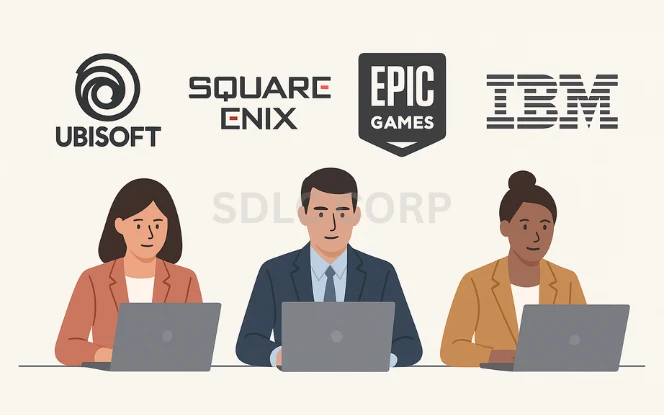
Major game studios and tech giants are not sitting on the sidelines. Ubisoft, Square Enix, and Epic Games have shown interest in blockchain integration. While some face backlash from traditional gamers wary of NFTs, the tide is gradually turning.
As the technology matures, we’ll likely see AAA titles incorporating blockchain features perhaps through cosmetic items, community governance, or interoperable gaming ecosystems built on blockchain standards.
Blockchain Gaming vs. Traditional Gaming: A Comparative Glimpse
| Feature | Traditional Gaming | Blockchain Gaming |
|---|---|---|
| Asset Ownership | Game Developer | Player via NFTs |
| Economic Model | Pay-to-Play/Freemium | Play-to-Earn |
| Transparency | Centralized & Opaque | Decentralized & Transparent |
| Interoperability | Rare/None | Possible via Blockchain Standards |
| Community Involvement | Limited Feedback Loops | Active Role via DAOs |
| Revenue Sharing | Mainly Developers/Publishers | Players, Creators, and Developers |
Future of Blockchain in the Gaming Industry
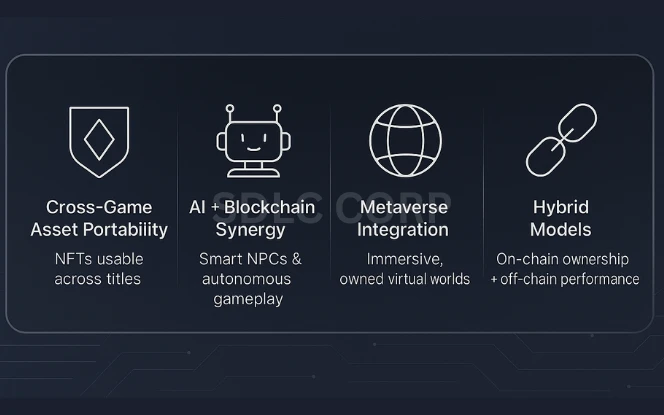
The future is decentralized. As technology evolves and adoption grows, blockchain is set to become a staple in the gaming industry. Here are a few trends to watch:
- Cross-Game Asset Portability: Imagine using a sword earned in one game inside another entirely different universe. With NFTs and interoperable standards, this future is within reach.
- AI + Blockchain Synergy: Intelligent NPCs (Non-Player Characters) governed by smart contracts could lead to autonomous worlds evolving independently.
- Metaverse Integration: Blockchain gaming is a natural extension of the metaverse—persistent, decentralized virtual worlds where players own their identity and assets.
- Hybrid Models: Developers might adopt hybrid approaches, where core gameplay remains off-chain, but asset ownership and transactions are on-chain, combining scalability and security.
- Mainstream Financial Inclusion: Blockchain games can serve as financial lifelines. Our crypto wallet development services provide the tools to power secure economic access.
Conclusion
The fusion of blockchain and gaming is more than a tech upgrade it’s a shift in power and ownership. It empowers players, fosters fair economies, and builds trust through transparency. From Play-to-Earn to decentralized governance, blockchain in gaming is redefining how we play and earn.
Challenges remain, but the momentum is strong. As adoption grows, blockchain gaming is on track to become the new standard—a revolution for players, creators, and investors alike.
Contact us to discuss your blockchain gaming project
FAQ's
1. What is Blockchain in Gaming?
Blockchain in gaming refers to the integration of blockchain technology into video games. This allows players to truly own in-game assets (like characters, skins, and items), facilitates secure transactions, and supports decentralized game mechanics through smart contracts.
2. How Does Blockchain Benefit the Gaming Industry?
Blockchain introduces transparency, true digital ownership, interoperable game assets, and Play-to-Earn models. It eliminates the need for intermediaries and gives players more control over their digital investments.
3. What Are NFTs in Blockchain Gaming?
NFTs (Non-Fungible Tokens) are unique, verifiable digital items that players can own and trade. In blockchain gaming, these might be rare characters, weapons, or cosmetics with real-world value and portability across games or marketplaces.
4. Can Players Make Money Through Blockchain Games?
Yes. Many blockchain gaming platforms feature Play-to-Earn mechanics, enabling users to earn crypto tokens or valuable NFTs simply by playing, trading, or completing in-game challenges.
5. Is Blockchain Gaming Safe and Secure?
Blockchain adds a strong layer of security through decentralized verification, making data tampering nearly impossible. However, players should use secure wallets and beware of scams or unaudited smart contracts.
6. Is Blockchain Gaming the Future of the Industry?
Absolutely. As developers and studios adopt decentralized models, blockchain in gaming is poised to become a major driver of innovation, offering player empowerment, financial opportunity, and next-gen gaming experiences.






